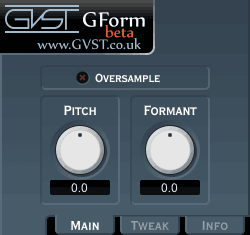GVST GForm
Pitch and formant shifter primarily for adjusting monophonic vocal recordings - free VST audio effect plug-in download for music production, broadcasting and general audio editing.
- Change the pitch of a vocal recording, or other monophonic signal, without varying the timing.
- Make a voice sound "deeper" or "higher" in tone, without changing the pitch.
For more details, read through the online manual below.
GForm Manual
Welcome to GForm
GForm is a formant/pitch shifting effect.
It's primarily intended for vocals, but you can experiment with applying it to any monophonic sound source.
GForm dpends on pitch-tracking, so it's unlikely to have any useful effect on rhythm, chords or multi-part records.
Shifting the pitch and formant of a vocal recording can alter its percieved age and gender.
Interface

The main user interface is straightforward with just three variables - pitch, formant and an oversample switch.
Pitch: This controls the pitch variation applied by the effect.
It is measured in semitones and has a range or +/- 12, so you can vary the pitch by up to an octave up or down.
The effect aims to alter the pitch without changing the timing.
Formant: This controls the formant variation applied by the effect.
It has the same range as the "pitch" parameter: +/- 12 semitones.
This controls the shift in the fundamental frequencies, without changing the pitch.
So, you could make a voice slightly "deeper" without actually making it lower in pitch.
Oversample: Engaging this switch will turn on oversampling.
In this mode the effect will operate at twice the native sampling frequency and then downsample the result.
This can sometimes help avoid unwanted aftefacts in the processed sound.
In addition to the main controls, there is a second page of settings accessed via the "Tweak" tab.
There are three further settings found on that tab that all.
Min Freq: This controls the lowest frequency that the processor will look for.
When the signal's pitch drops below this, it is simply ignored.
Narrowing the expected frequency range can make the pitch detection more efficient and more accurate.
Max Freq: This is the counterpart to the "Min Freq" setting that specifies the upper end of the range.
As mentioned, this pair of settings can help with the pitch detection underlying the effect.
Gate: Similar to the frequency limit parameters, this specifies a volume floor.
The pitch detection will ignore the input if it drops below this level.
Again, this helps to make the pitch detection more efficient and accurate.
Hints and ideas
-
Broadly speaking, raising the pitch and formant will make a voice recording seem "younger" or "more feminine", while lowering the same can make the voice seem "older" or "more masculine".
-
If you record multi-part harmonies with a single voice, you can experiment with changing the formant of the backing vocals to make the sound richer and more varied.
-
With extreme settings you can create a chipmunk or demonic effect on spoken or sung vocals.

